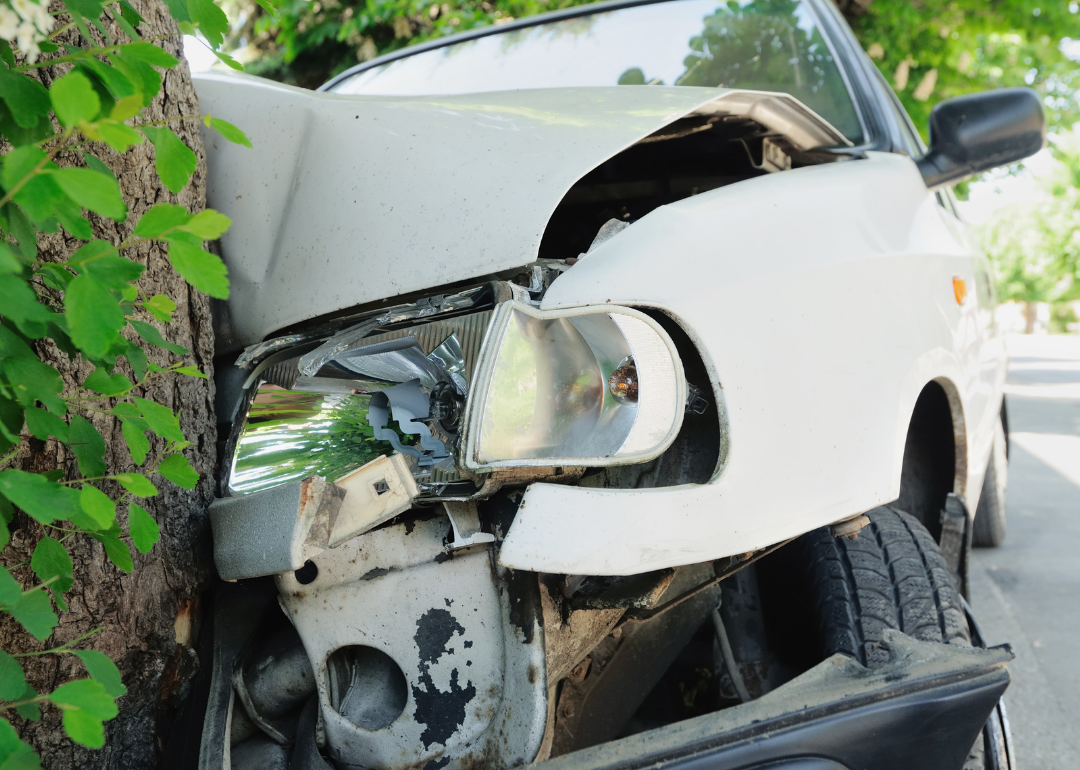
This story originally appeared on Stacker and was produced and distributed in partnership with Stacker Studio.
States with the most motor vehicle deaths in 2020
Americans drove an estimated 13% fewer miles in 2020, likely due to stay-at-home orders during the pandemic, yet the country experienced an astounding 24% jump in the rate of road-related deaths over the year before, according to the National Safety Council (NSC). The jump represents the largest year-over-year increase calculated by the NSC in 96 years, which representatives say highlights the dire need for the U.S. to prioritize road safety.
CoPilot analyzed preliminary data from the National Safety Council, released on March 4, 2020, to determine the 10 states with the most motor vehicle deaths in 2020. States are ranked according to the number of deaths per 100,000 people, and ties are broken by the state total number of motor vehicle deaths in 2020. Population estimates were obtained from the U.S. Census Bureau, released on July 1, 2020.
There were 42,060 total motor vehicle deaths in 2020 across the United States, an 8% increase since 2019. Only nine states saw a decrease in the number of fatalities between 2019 and 2020: New Mexico, Wyoming, North Dakota, Maine, Delaware, Nebraska, Idaho, Alaska, and Hawaii.
In a statement, NSC president and CEO Lorraine M. Martin remarked, “It is tragic that in the U.S., we took cars off the roads and didn't reap any safety benefits.” In an interview with NPR, Martin surmised that less traffic led drivers to engage in risky behaviors such driving without a seatbelt on, speeding, or driving while impaired or distracted. Full analysis of the causes behind the major increase in road-related deaths by various organizations are ongoing.
Besides the obvious cost of human life, roadway accidents cost an estimated $474 billion in 2020. NSC, along with more than 1,500 fellow organizations, in January 2021 sent a letter to the Biden administration calling for a commitment to zero roadway fatalities by 2050. NSC’s Road to Zero Coalition suggests this goal could be met by taking actions such as banning all cell phone use, lowering speed limits, reinstating or passing motorcycle helmet laws, and adopting bicyclist and pedestrian safety programs in communities across the country.

#10. Kentucky
- 2020 motor vehicle deaths: 774 (17.3 deaths per 100,000 in Kentucky)
- 2019 motor vehicle deaths: 733
- Change in fatalities between 2019-2020: +6%
On March 12, 2021, local law enforcement partnered with Tennessee Highway Patrol in a safety initiative aimed at averting injuries and fatalities along I-24 in multiple counties called Operation Impact 24. Law enforcement focused on dangerous behaviors such as hazardous moving violations and distracted driving, including hands-free violations.

#9. Louisiana
- 2020 motor vehicle deaths: 805 (17.3 deaths per 100,000 in Louisiana)
- 2019 motor vehicle deaths: 722
- Change in fatalities between 2019-2020: +11%
As of Jan. 1, 2021, Louisiana requires those under 18 applying for a license to prove they have taken a driver education course: at least 30 hours in the classroom and no less than eight hours behind the wheel. The exception is if the driver has completed a prelicensing training course consisting of six hours in the classroom and eight hours of driving instruction.

#8. Tennessee
- 2020 motor vehicle deaths: 1,231 (17.9 deaths per 100,000 in Tennessee)
- 2019 motor vehicle deaths: 1,148
- Change in fatalities between 2019-2020: +7%
As of July 1, 2019, drivers caught holding a phone with any part of their body while behind the wheel can be issued a traffic citation and fined anywhere from $50 to $200. In 2019, more than 23,700 car accidents in the state involved a distracted driver, according to the Tennessee Highway Safety Office.

#7. New Mexico
- 2020 motor vehicle deaths: 390 (18.5 deaths per 100,000 in New Mexico)
- 2019 motor vehicle deaths: 407
- Change in fatalities between 2019-2020: -4%
The most common factors contributing to car accidents in New Mexico in 2020 were failing to wear a seat belt, distracted driving, and driving drunk, according to the New Mexico Department of Transportation. NMDOT launched a campaign to help stop dangerous driving behaviors; the animated videos tell stories from the perspective of a child and focus on loss caused by preventable traffic fatalities.

#6. Alabama
- 2020 motor vehicle deaths: 930 (18.9 deaths per 100,000 in Alabama)
- 2019 motor vehicle deaths: 883
- Change in fatalities between 2019-2020: +5%
Three driving-related laws went into effect in 2019 including the Anti-Road-Rage Law, which makes it illegal to drive in the left lane for over 1.5 miles without passing another driver. Another law made it illegal for backseat passengers to not wear a seat belt. Fines also became higher for drivers who fail to move to another lane or decrease their speed when driving past an emergency vehicle that is stopped.

#5. Montana
- 2020 motor vehicle deaths: 211 (19.5 deaths per 100,000 in Montana)
- 2019 motor vehicle deaths: 184
- Change in fatalities between 2019-2020: +15%
In March 2021, Gov. Greg Gianforte signed a bill that allows motorcyclists to filter between lanes of slow-moving or stopped vehicles as long as it is safe to do so and the motorcyclist’s speed is less than 20 mph. Research from California and the University of California-Berkeley research has shown that lane splitting can actually boost motorcycle safety. The bill will go into effect on Oct. 1, making Montana the third state to pass this type of legislation.

#4. South Carolina
- 2020 motor vehicle deaths: 1,025 (19.6 deaths per 100,000 in South Carolina)
- 2019 motor vehicle deaths: 985
- Change in fatalities between 2019-2020: +4%
The number of driving-under-the-influence arrests made in 2020 declined 14% from the prior year, which some attribute to COVID-19 restrictions, including one that moved the “last call order” at bars and restaurants back to 11 p.m., though that has since been lifted. Emma’s Law, named in honor for a child killed in a drunk-driving crash in 2012, took effect in 2014, but some have criticized the law for its leniency—it only requires an ignition interlock system (an in-car breathalyzer) for drivers who registered no less than a .15 blood alcohol level. South Carolina's Mothers Against Drunk Driving in South Carolina has advocated for the device to be required for every DUI charge (.08).

#3. Arkansas
- 2020 motor vehicle deaths: 638 (21.1 deaths per 100,000 in Arkansas)
- 2019 motor vehicle deaths: 506
- Change in fatalities between 2019-2020: +26%
Arkansas is one of only two states to have a law on the books explicitly addressing driving while sleepy (the other is New Jersey). In Arkansas it is illegal to drive while “in the state of being asleep” or while knowingly fatigued, defined as going without sleep for more than 24 hours. And one city in Arkansas is trying to make school busses safer by outfitting them with seat belts. While children are actually safer in a bus than a car, there are still four to six children who die every year on school transportation vehicles, according to the National Highway Traffic Safety Administration.

#2. Wyoming
- 2020 motor vehicle deaths: 128 (22.0 deaths per 100,000 in Wyoming)
- 2019 motor vehicle deaths: 147
- Change in fatalities between 2019-2020: -13%
In 2020, Wyoming had more alcohol-related driving deaths per 100,000 people, the most out of any state, according to NHTSA. Mothers Against Drunk Driving has suggested that Wyoming should pass a law that requires all offenders, not just those who registered a .15 BAC, to use an ignition interlock system and for the state to legalize sobriety checkpoints.

#1. Mississippi
- 2020 motor vehicle deaths: 736 (24.8 deaths per 100,000 in Mississippi)
- 2019 motor vehicle deaths: 616
- Change in fatalities between 2019-2020: +19%
Mississippi Highway Patrol launched a campaign in early 2021 called Driving Requires Initiative Values and Education (DRIVE) to help prevent teen driving fatalities, which spiked in 2020. The MHP reports that the state is ranked in the top five when it comes to teen driving deaths. The campaign plans to change these statistics through education at schools and community centers, with a focus on the importance of wearing a seatbelt and avoiding distracted driving.



